HYUNDAI VELOSTER 2015 Owners Manual
Manufacturer: HYUNDAI, Model Year: 2015, Model line: VELOSTER, Model: HYUNDAI VELOSTER 2015Pages: 384, PDF Size: 25 MB
Page 361 of 384
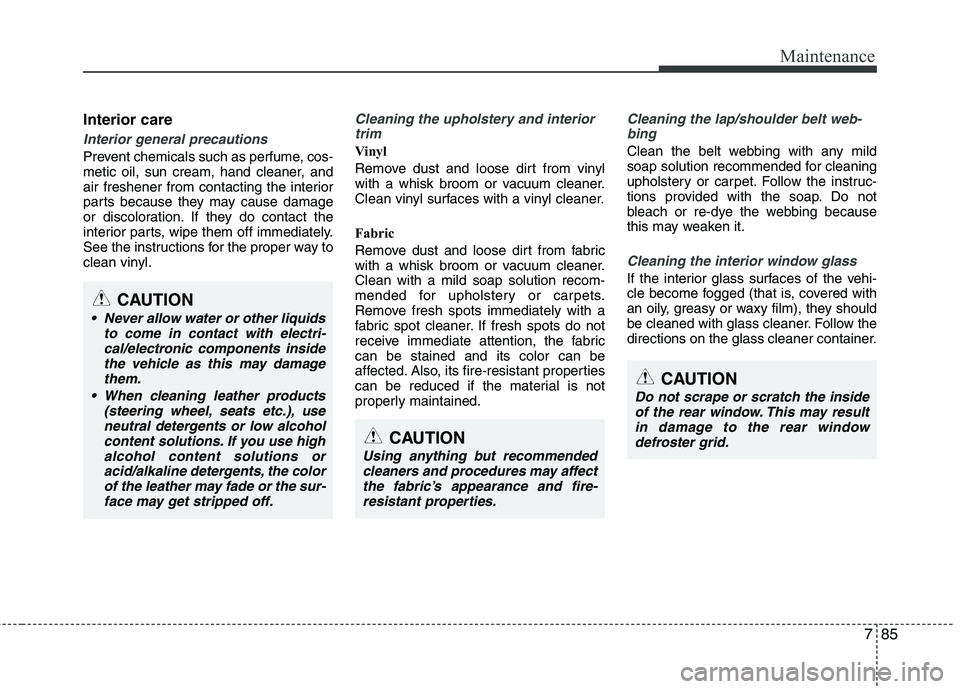
785
Maintenance
Interior care
Interior general precautions
Prevent chemicals such as perfume, cos-
metic oil, sun cream, hand cleaner, and
air freshener from contacting the interior
parts because they may cause damage
or discoloration. If they do contact the
interior parts, wipe them off immediately.
See the instructions for the proper way to
clean vinyl.
Cleaning the upholstery and interior
trim
Vinyl
Remove dust and loose dirt from vinyl
with a whisk broom or vacuum cleaner.
Clean vinyl surfaces with a vinyl cleaner.
Fabric
Remove dust and loose dirt from fabric
with a whisk broom or vacuum cleaner.
Clean with a mild soap solution recom-
mended for upholstery or carpets.
Remove fresh spots immediately with a
fabric spot cleaner. If fresh spots do not
receive immediate attention, the fabric
can be stained and its color can be
affected. Also, its fire-resistant properties
can be reduced if the material is not
properly maintained.
Cleaning the lap/shoulder belt web-
bing
Clean the belt webbing with any mild
soap solution recommended for cleaning
upholstery or carpet. Follow the instruc-
tions provided with the soap. Do not
bleach or re-dye the webbing because
this may weaken it.
Cleaning the interior window glass
If the interior glass surfaces of the vehi-
cle become fogged (that is, covered with
an oily, greasy or waxy film), they should
be cleaned with glass cleaner. Follow the
directions on the glass cleaner container.
CAUTION
Never allow water or other liquids
to come in contact with electri-
cal/electronic components inside
the vehicle as this may damage
them.
When cleaning leather products
(steering wheel, seats etc.), use
neutral detergents or low alcohol
content solutions. If you use high
alcohol content solutions or
acid/alkaline detergents, the color
of the leather may fade or the sur-
face may get stripped off.
CAUTION
Using anything but recommended
cleaners and procedures may affect
the fabric’s appearance and fire-
resistant properties.
CAUTION
Do not scrape or scratch the inside
of the rear window. This may result
in damage to the rear window
defroster grid.
Page 362 of 384
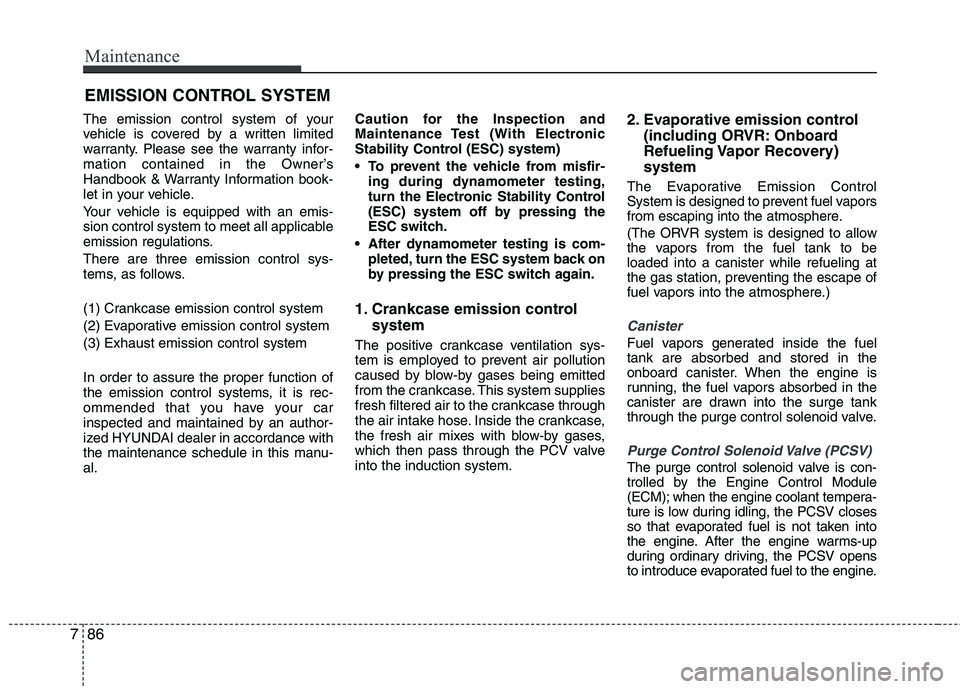
Maintenance
86 7
EMISSION CONTROL SYSTEM
The emission control system of your
vehicle is covered by a written limited
warranty. Please see the warranty infor-
mation contained in the Owner’s
Handbook & Warranty Information book-
let in your vehicle.
Your vehicle is equipped with an emis-
sion control system to meet all applicable
emission regulations.
There are three emission control sys-
tems, as follows.
(1) Crankcase emission control system
(2) Evaporative emission control system
(3) Exhaust emission control system
In order to assure the proper function of
the emission control systems, it is rec-
ommended that you have your car
inspected and maintained by an author-
ized HYUNDAI dealer in accordance with
the maintenance schedule in this manu-
al.Caution for the Inspection and
Maintenance Test (With Electronic
Stability Control (ESC) system)
To prevent the vehicle from misfir-
ing during dynamometer testing,
turn the Electronic Stability Control
(ESC) system off by pressing the
ESC switch.
After dynamometer testing is com-
pleted, turn the ESC system back on
by pressing the ESC switch again.
1. Crankcase emission control
system
The positive crankcase ventilation sys-
tem is employed to prevent air pollution
caused by blow-by gases being emitted
from the crankcase. This system supplies
fresh filtered air to the crankcase through
the air intake hose. Inside the crankcase,
the fresh air mixes with blow-by gases,
which then pass through the PCV valve
into the induction system.
2. Evaporative emission control
(including ORVR: Onboard
Refueling Vapor Recovery)
system
The Evaporative Emission Control
System is designed to prevent fuel vapors
from escaping into the atmosphere.
(The ORVR system is designed to allow
the vapors from the fuel tank to be
loaded into a canister while refueling at
the gas station, preventing the escape of
fuel vapors into the atmosphere.)
Canister
Fuel vapors generated inside the fuel
tank are absorbed and stored in the
onboard canister. When the engine is
running, the fuel vapors absorbed in the
canister are drawn into the surge tank
through the purge control solenoid valve.
Purge Control Solenoid Valve (PCSV)
The purge control solenoid valve is con-
trolled by the Engine Control Module
(ECM); when the engine coolant tempera-
ture is low during idling, the PCSV closes
so that evaporated fuel is not taken into
the engine. After the engine warms-up
during ordinary driving, the PCSV opens
to introduce evaporated fuel to the engine.
Page 363 of 384
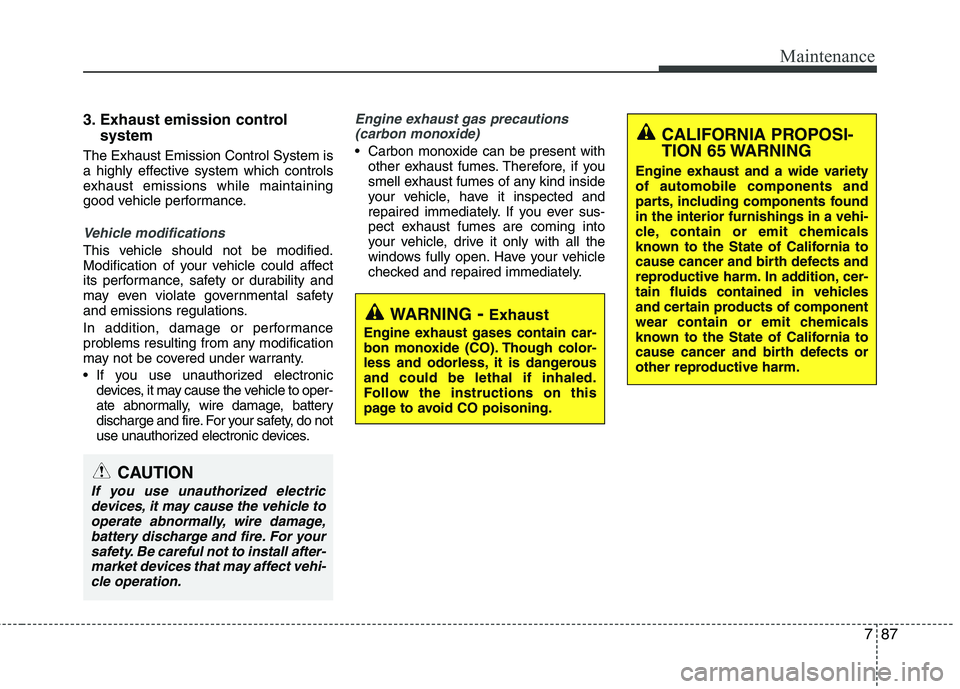
787
Maintenance
3. Exhaust emission control
system
The Exhaust Emission Control System is
a highly effective system which controls
exhaust emissions while maintaining
good vehicle performance.
Vehicle modifications
This vehicle should not be modified.
Modification of your vehicle could affect
its performance, safety or durability and
may even violate governmental safety
and emissions regulations.
In addition, damage or performance
problems resulting from any modification
may not be covered under warranty.
If you use unauthorized electronic
devices, it may cause the vehicle to oper-
ate abnormally, wire damage, battery
discharge and fire. For your safety, do not
use unauthorized electronic devices.
Engine exhaust gas precautions
(carbon monoxide)
Carbon monoxide can be present with
other exhaust fumes. Therefore, if you
smell exhaust fumes of any kind inside
your vehicle, have it inspected and
repaired immediately. If you ever sus-
pect exhaust fumes are coming into
your vehicle, drive it only with all the
windows fully open. Have your vehicle
checked and repaired immediately.
WARNING- Exhaust
Engine exhaust gases contain car-
bon monoxide (CO). Though color-
less and odorless, it is dangerous
and could be lethal if inhaled.
Follow the instructions on this
page to avoid CO poisoning.
CALIFORNIA PROPOSI-
TION 65 WARNING
Engine exhaust and a wide variety
of automobile components and
parts, including components found
in the interior furnishings in a vehi-
cle, contain or emit chemicals
known to the State of California to
cause cancer and birth defects and
reproductive harm. In addition, cer-
tain fluids contained in vehicles
and certain products of component
wear contain or emit chemicals
known to the State of California to
cause cancer and birth defects or
other reproductive harm.
CAUTION
If you use unauthorized electric
devices, it may cause the vehicle to
operate abnormally, wire damage,
battery discharge and fire. For your
safety. Be careful not to install after-
market devices that may affect vehi-
cle operation.
Page 364 of 384
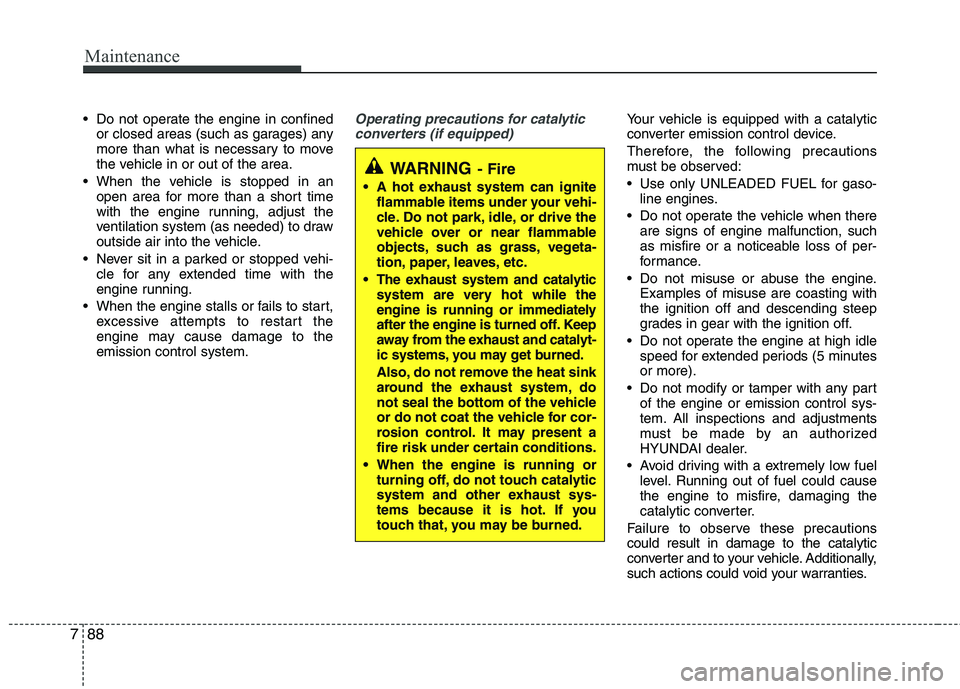
Maintenance
88 7
Do not operate the engine in confined
or closed areas (such as garages) any
more than what is necessary to move
the vehicle in or out of the area.
When the vehicle is stopped in an
open area for more than a short time
with the engine running, adjust the
ventilation system (as needed) to draw
outside air into the vehicle.
Never sit in a parked or stopped vehi-
cle for any extended time with the
engine running.
When the engine stalls or fails to start,
excessive attempts to restart the
engine may cause damage to the
emission control system.Operating precautions for catalytic
converters (if equipped)Your vehicle is equipped with a catalytic
converter emission control device.
Therefore, the following precautions
must be observed:
Use only UNLEADED FUEL for gaso-
line engines.
Do not operate the vehicle when there
are signs of engine malfunction, such
as misfire or a noticeable loss of per-
formance.
Do not misuse or abuse the engine.
Examples of misuse are coasting with
the ignition off and descending steep
grades in gear with the ignition off.
Do not operate the engine at high idle
speed for extended periods (5 minutes
or more).
Do not modify or tamper with any part
of the engine or emission control sys-
tem. All inspections and adjustments
must be made by an authorized
HYUNDAI dealer.
Avoid driving with a extremely low fuel
level. Running out of fuel could cause
the engine to misfire, damaging the
catalytic converter.
Failure to observe these precautions
could result in damage to the catalytic
converter and to your vehicle. Additionally,
such actions could void your warranties.
WARNING- Fire
A hot exhaust system can ignite
flammable items under your vehi-
cle. Do not park, idle, or drive the
vehicle over or near flammable
objects, such as grass, vegeta-
tion, paper, leaves, etc.
The exhaust system and catalytic
system are very hot while the
engine is running or immediately
after the engine is turned off. Keep
away from the exhaust and catalyt-
ic systems, you may get burned.
Also, do not remove the heat sink
around the exhaust system, do
not seal the bottom of the vehicle
or do not coat the vehicle for cor-
rosion control. It may present a
fire risk under certain conditions.
When the engine is running or
turning off, do not touch catalytic
system and other exhaust sys-
tems because it is hot. If you
touch that, you may be burned.
Page 365 of 384
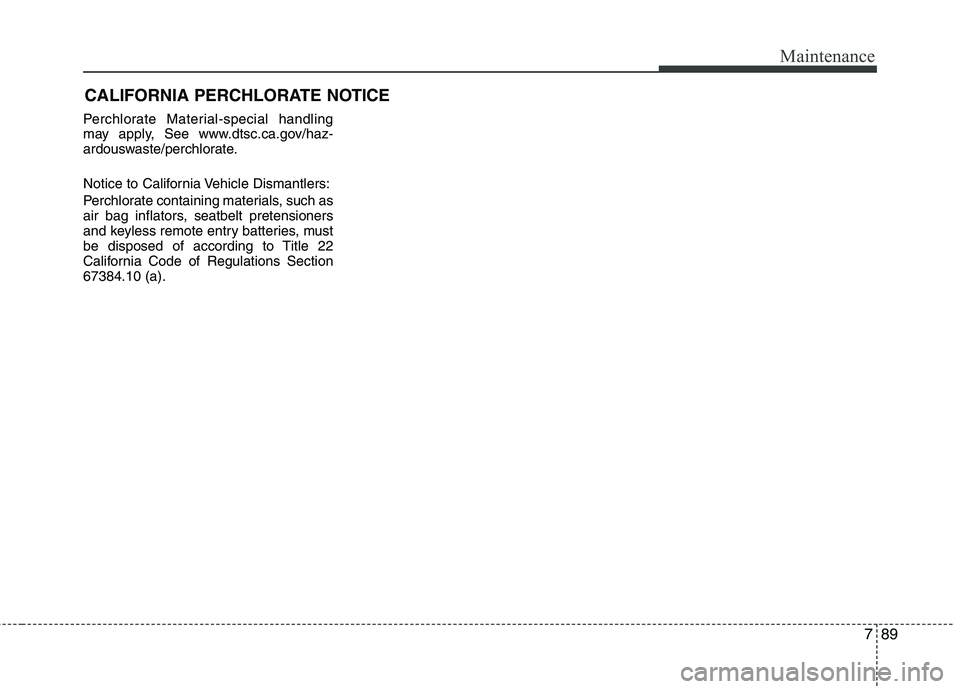
789
Maintenance
CALIFORNIA PERCHLORATE NOTICE
Perchlorate Material-special handling
may apply, See www.dtsc.ca.gov/haz-
ardouswaste/perchlorate.
Notice to California Vehicle Dismantlers:
Perchlorate containing materials, such as
air bag inflators, seatbelt pretensioners
and keyless remote entry batteries, must
be disposed of according to Title 22
California Code of Regulations Section
67384.10 (a).
Page 366 of 384
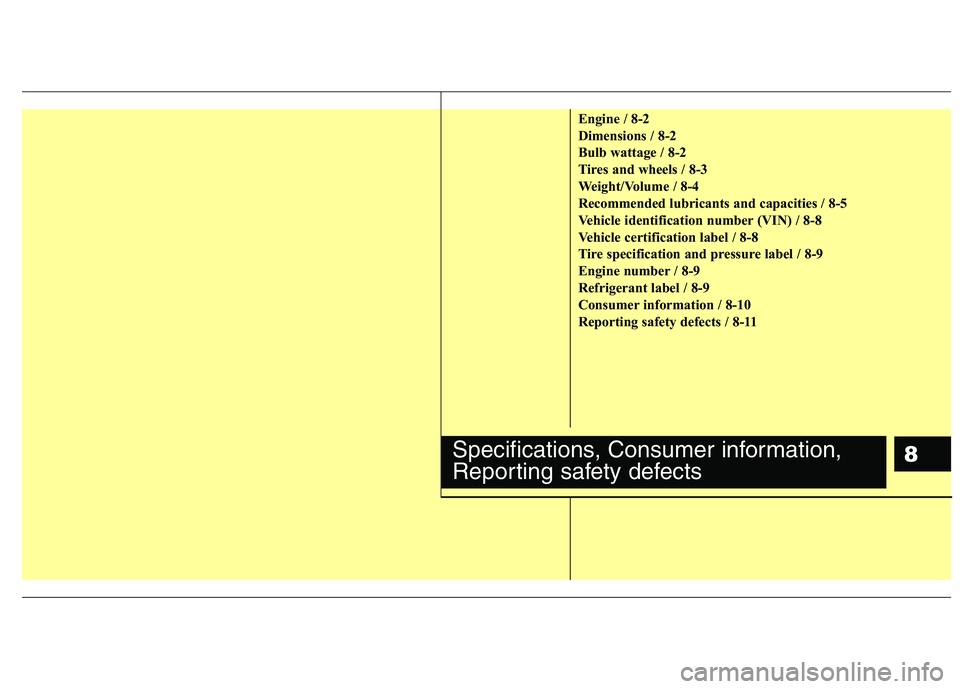
8
Engine / 8-2
Dimensions / 8-2
Bulb wattage / 8-2
Tires and wheels / 8-3
Weight/Volume / 8-4
Recommended lubricants and capacities / 8-5
Vehicle identification number (VIN) / 8-8
Vehicle certification label / 8-8
Tire specification and pressure label / 8-9
Engine number / 8-9
Refrigerant label / 8-9
Consumer information / 8-10
Reporting safety defects / 8-11
Specifications, Consumer information,
Reporting safety defects
Page 367 of 384
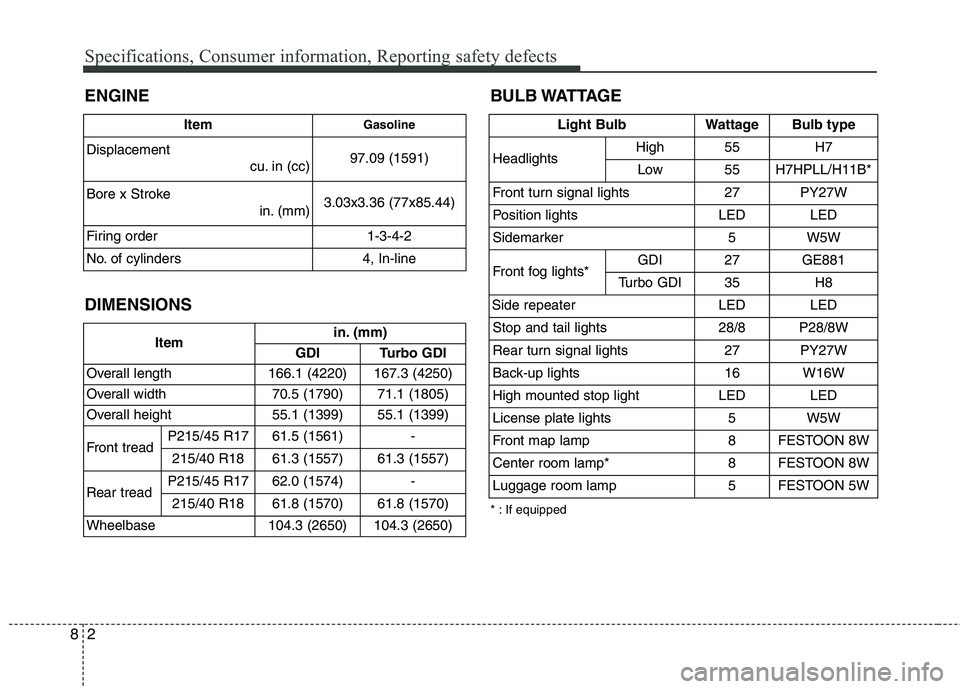
Specifications, Consumer information, Reporting safety defects
2 8
ENGINE
DIMENSIONS
Itemin. (mm)
GDI Turbo GDI
Overall length 166.1 (4220) 167.3 (4250)
Overall width 70.5 (1790) 71.1 (1805)
Overall height 55.1 (1399) 55.1 (1399)
Front treadP215/45 R17 61.5 (1561) -
215/40 R18 61.3 (1557) 61.3 (1557)
Rear treadP215/45 R17 62.0 (1574) -
215/40 R18 61.8 (1570) 61.8 (1570)
Wheelbase 104.3 (2650) 104.3 (2650)
ItemGasoline
Displacement
cu. in (cc) 97.09 (1591)
Bore x Stroke
in. (mm)3.03x3.36 (77x85.44)
Firing order 1-3-4-2
No. of cylinders 4, In-line
BULB WATTAGE
Light BulbWattageBulb type
HeadlightsHigh55H7
Low55H7HPLL/H11B*
Front turn signal lights27PY27W
Position lightsLEDLED
Sidemarker5W5W
Front fog lights*GDI27GE881
Turbo GDI35H8
Side repeaterLEDLED
Stop and tail lights28/8P28/8W
Rear turn signal lights 27PY27W
Back-up lights16W16W
High mounted stop lightLEDLED
License plate lights5W5W
Front map lamp8FESTOON 8W
Center room lamp*8FESTOON 8W
Luggage room lamp5FESTOON 5W
* : If equipped
Page 368 of 384
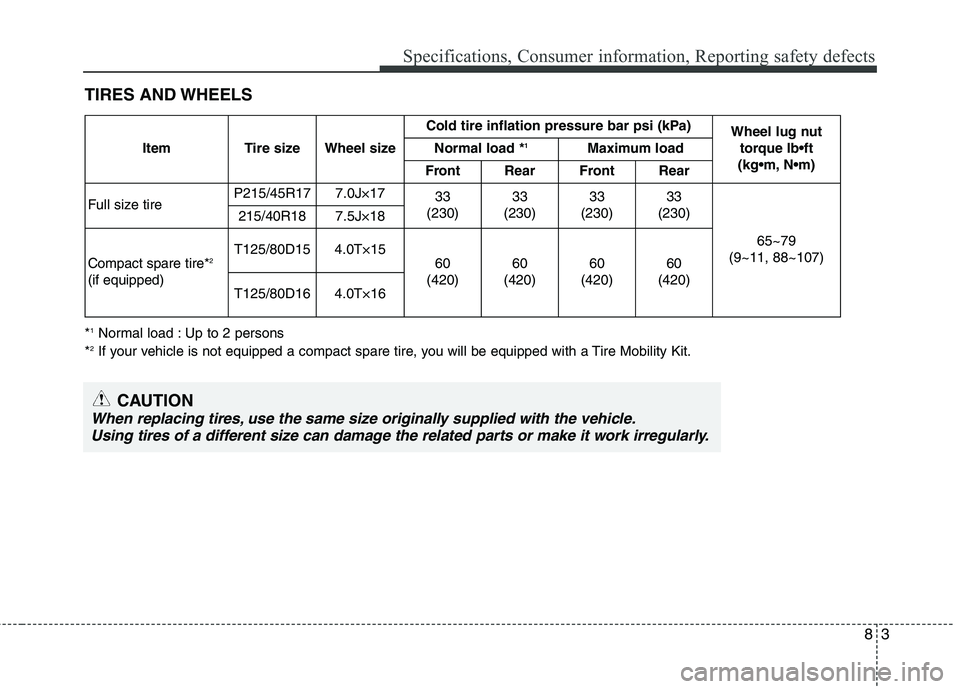
83
Specifications, Consumer information, Reporting safety defects
TIRES AND WHEELS
CAUTION
When replacing tires, use the same size originally supplied with the vehicle.
Using tires of a different size can damage the related parts or make it work irregularly.
Item Tire size Wheel sizeCold tire inflation pressure bar psi (kPa)
Wheel lug nut
torque lb•ft
Normal load *1Maximum load
Front Rear Front Rear
Full size tireP215/45R17 7.0J×17
33
(230)33
(230)33
(230)33
(230)
65~79
(9~11, 88~107) 215/40R18 7.5J×18
Compact spare tire*
2
(if equipped)T125/80D15 4.0T×15
60
(420)60
(420)60
(420)60
(420)
T125/80D16 4.0T×16
*1Normal load : Up to 2 persons
*2If your vehicle is not equipped a compact spare tire, you will be equipped with a Tire Mobility Kit.
Page 369 of 384

Specifications, Consumer information, Reporting safety defects
4 8
WEIGHT/VOLUME
Item GDI Turbo GDI
Gross vehicle weight
lbs. (kg)Manual transaxle 3748 (1700) 3854 (1750)
Automatic transaxle3748 (1700)3854 (1750)
EcoShift dual clutch transmission3748 (1700)3854 (1750)
Luggage volume
cu ft (l)15.5 (440)
Page 370 of 384
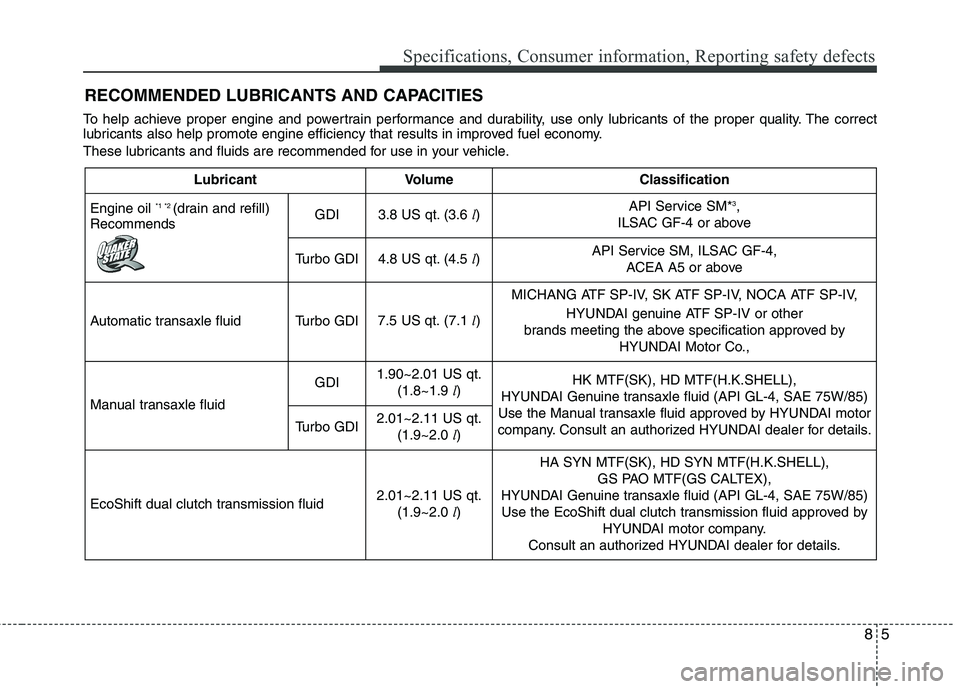
85
Specifications, Consumer information, Reporting safety defects
RECOMMENDED LUBRICANTS AND CAPACITIES
To help achieve proper engine and powertrain performance and durability, use only lubricants of the proper quality. The correct
lubricants also help promote engine efficiency that results in improved fuel economy.
These lubricants and fluids are recommended for use in your vehicle.
LubricantVolumeClassification
Engine oil *1 *2 (drain and refill)
RecommendsGDI3.8 US qt. (3.6 l)API Service SM*3,
ILSAC GF-4 or above
Turbo GDI4.8 US qt. (4.5 l)API Service SM, ILSAC GF-4,
ACEA A5 or above
Automatic transaxle fluidTurbo GDI7.5 US qt. (7.1 l)
MICHANG ATF SP-IV, SK ATF SP-IV, NOCA ATF SP-IV,
HYUNDAI genuine ATF SP-IV or other
brands meeting the above specification approved by
HYUNDAI Motor Co.,
Manual transaxle fluid
GDI1.90~2.01 US qt.
(1.8~1.9 l)HK MTF(SK), HD MTF(H.K.SHELL),
HYUNDAI Genuine transaxle fluid (API GL-4, SAE 75W/85)
Use the Manual transaxle fluid approved by HYUNDAI motor
company. Consult an authorized HYUNDAI dealer for details.
Turbo GDI2.01~2.11 US qt.
(1.9~2.0 l)
EcoShift dual clutch transmission fluid2.01~2.11 US qt.
(1.9~2.0 l)
HA SYN MTF(SK), HD SYN MTF(H.K.SHELL),
GS PAO MTF(GS CALTEX),
HYUNDAI Genuine transaxle fluid (API GL-4, SAE 75W/85)
Use the EcoShift dual clutch transmission fluid approved by
HYUNDAI motor company.
Consult an authorized HYUNDAI dealer for details.